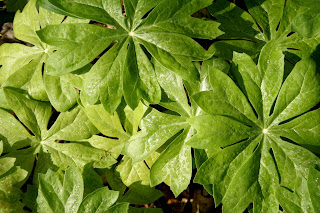On our land, there is a steep hollow or cove. The only time I go there is in the third week of April to check out the trillium. Today, I realized I hadn't done so so I went, thinking I was too late to see the blooms.

Photo: April 30, 2008
I spotted a Large Flowered Trillium right away.

Photo: April 30, 2008
A Tiger Swallowtail was busy feeding on the nectar on this pink-colored trillium flower.
As I ventured further up the hollow, I realized I had gone at the perfect time---more trillium than I ever remember seeing. They lined both sides of the cove, maybe several thousand but way too many to count. I don't know if this was a good year or if I had just timed it perfectly.

Photo: April 30, 2008
It is hard to see from this photo but the trillium carpet this slope.

Photo: April 30, 2008
Coming back, I walked by this moss-covered log with a large mushroom growing on it, the same type of mushroom that has grown on it for several years. Sophie, our rather large cat, posed with it so you can get a good idea of how big it is--the cap was a good 9 inches in diameter.

Photos: April 30, 2008
The mushroom does not have gills--more like sponge underneath. If anyone knows what type of mushroom this is, please let me know.






















